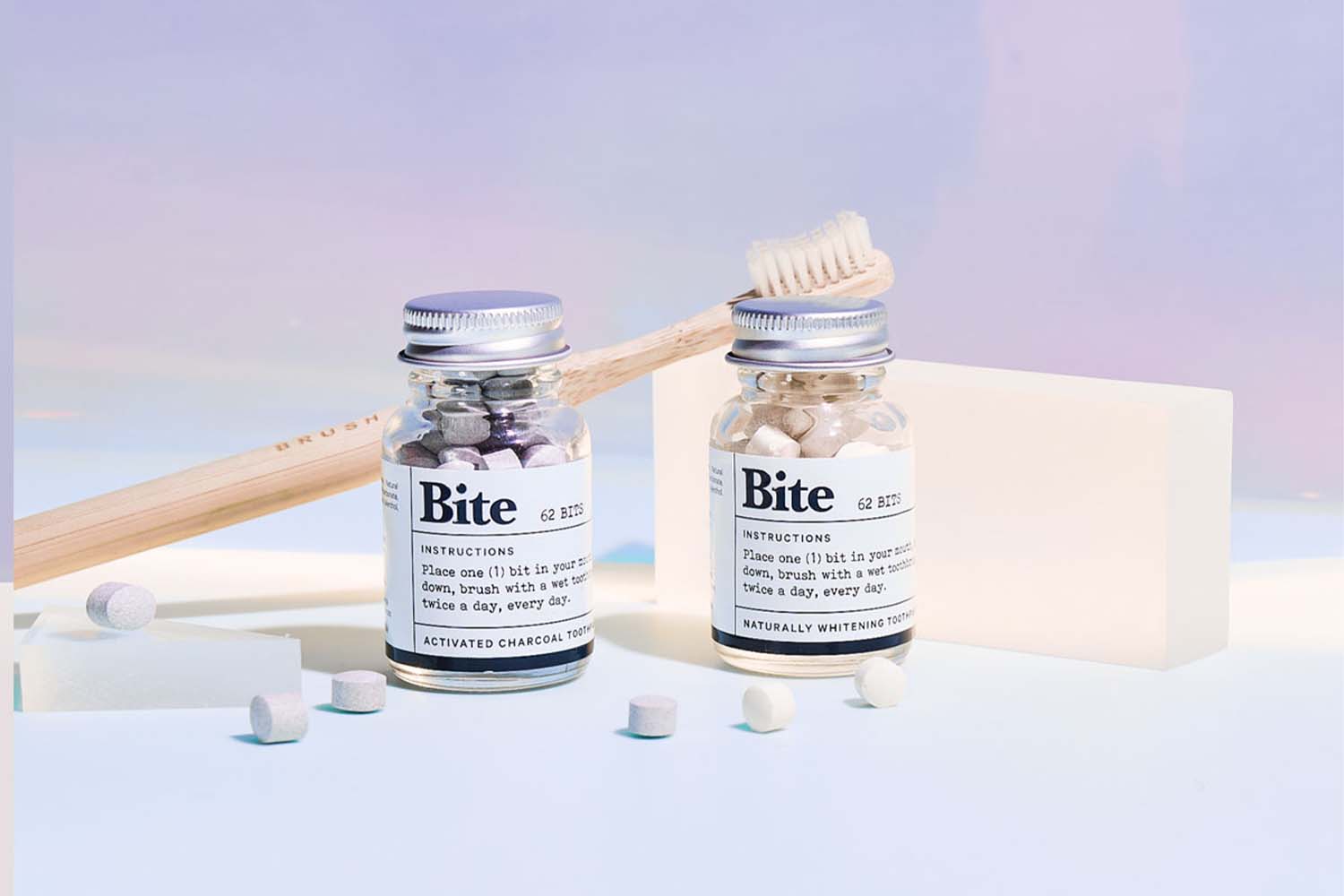Fluoride vs. Fluoride Free Bite Toothpaste Bits
While fluoride has been added to most toothpaste for the past seventy years, multiple ingredients can provide similar dental health benefits for those who prefer a fluoride-free option.
But, we’re getting ahead of ourselves.
What exactly is fluoride, why is it so commonly added to toothpaste, and how can you decide whether a fluoride or fluoride-free toothpaste option is right for you?
We’re covering the key differences and benefits of fluoride and non-fluoride toothpaste so you can choose your next toothpaste with confidence and ease.
What Is Fluoride Toothpaste?
Fluoride is a mineral found within rocks that is then released into the air, soil, and water. While many natural water sources water, we typically do not consume enough fluoride naturally to experience any effects.
However, early research found that some communities are more exposed to fluoride through their water supply than others. A connection between fluoride exposure and oral health was made in the mid-1900s when researchers found that in areas where the water contained naturally high concentrations of fluoride, community members had surprisingly strong teeth enamel and low rates of tooth decay.
Studies were set in motion to find the optimal amount of fluoride to benefit our teeth without negatively impacting our health. As water fluoridation was proven to reduce the risk of dental decay, fluoride treatment became more popular across the country. Many of us are now exposed to tested and safe amounts of fluoride through our drinking water.
Right as water fluoridation was taking off in the 1940s and 1950s, toothpaste companies began to explore the benefits of adding fluoride directly into toothpaste as well. Studies found that fluoride toothpaste was another effective way to strengthen the teeth. Manufacturers launched the first fluoride toothpaste in 1955, and fluoride toothpaste quickly became popular.
How Does Fluoride Work?
When we use fluoride toothpaste, the fluoride is absorbed into the teeth, joining other minerals that work to protect the teeth.
Once absorbed, fluoride can help prevent cavities by joining forces with calcium and phosphate to form a compound known as fluorapatite. Fluorapatite works to reduce tooth decay by helping reduce plaque buildup and slow demineralization.
Why Should You Use Fluoride Toothpaste?
The use of fluoride toothpaste can provide many benefits that ultimately help fight off cavities — also known as dental caries or tooth decay. These small holes in the tooth can occur when the teeth sustain damage from bacteria and plaque buildup, eventually affecting the nerves within the tooth.
What Are the Benefits of Fluoride Toothpaste?
So how exactly does fluoride prevent cavities and support teeth health? Here are some of the main benefits of fluoride.
Remineralization
Fluoride promotes the remineralization of enamel, a process that is vital for overall tooth health.
Enamel is the hard outer layer of the tooth that protects the more sensitive inner parts of the tooth.
Our tooth enamel contains several strengthening minerals such as phosphate and calcium. These minerals help shield the teeth from harm, but when bacteria produce acid from the sugars and starches that cling to the teeth, the acid can eat away at these minerals. This process is called demineralization.
With the loss of vital minerals, our protective enamel can become weaker and more vulnerable to acid-producing bacteria. And as acid continues to erode the enamel, it exposes the more sensitive dentin underneath. If your enamel is weakened from the loss of minerals, you may experience increased sensitivity and discomfort.
Luckily, fluoride helps slow demineralization and can support remineralization by reintroducing lost minerals. By providing the minerals needed to strengthen the enamel, fluoride can help reduce the risk and reverse some early stages of tooth decay.
Antibacterial Properties
Fluoride can help prevent bacteria from eating away at our teeth by limiting their ability to form acid.
The acid can create holes in the enamel that allow bacteria to move further toward the center of the teeth. Once deep within the tooth, bacteria can cause irritation that presses the tooth’s nerve, leading to increased pain and sensitivity.
But, if bacteria can’t efficiently produce the acid known to form plaque and break down the enamel, the bacteria cannot force their way deeper into the teeth. Fluoride’s antibacterial properties can help prevent this harmful acid and work to keep our teeth strong and safe.
Reduces Plaque Buildup
Plaque can form after eating sugary or sticky foods. When sugars remain on the teeth, bacteria in the mouth can easily turn them into acids, eventually forming the teeth-clinging film known as plaque. If the plaque isn’t removed quickly, it can harden into tartar, a deposit that is harder to remove as it provides a shield for bacteria.
By helping clear away plaque and hindering the production of acid that leads to tartar, fluoride can help prevent cavities and even reverse the early stages of plaque formation.
Are There Risks Associated With Fluoride?
Fluoride is generally considered safe. Typically, the only negative side effects that take place occur if large amounts of fluoride are ingested.
Since we spit out our toothpaste, and our fluoridated water supply is monitored and adjusted for safety and cavity prevention, the risk of fluoride overconsumption is extremely low for most people.
Our fluoride bits here at Bite have the perfect amount of fluoride per bit. Instead of storing them in the 4oz jar like our fluoride-free formula, we put them in a 2oz jar to ensure safety and minimize any risk of overconsumption.
However, some people are sensitive or allergic to fluoride and may prefer toothpaste without it.
Is Fluoride Toothpaste Safe for Younger Children and Babies?
While fluoride is generally safe, consuming too much while the teeth are still forming can lead to the formation of white or discolored spots on the teeth, known as dental fluorosis.
To prevent the overconsumption of fluoride and the associated risks, fluoride toothpaste isn’t recommended for young children under three years of age.
While older children can safely use fluoride toothpaste, they should only use a pea-sized amount when brushing and should be supervised to reduce the likelihood of swallowing any toothpaste.
What Ingredients Are Used in Non-Fluoride Toothpaste?
Many fluoride-free toothpastes incorporate other natural ingredients such as green tea extract, papaya plant extract, or baking soda extract meant to help polish the teeth and reduce bacteria. However, it is important to note that some fluoride alternatives are proven to work better than others.
Here at Bite, we only use safe, science-backed ingredients in our non-fluoride toothpaste, such as nano-hydroxyapatite (nHAP) to support enamel remineralization and xylitol to help repel dental plaque-forming bacteria.
NHAP is a calcium crystal that NASA developed in the 1970s to prevent the loss of tooth and bone mass in space, and it does so by mimicking a mineral that is naturally occurring within our bones.
Hydroxyapatite is a form of calcium apatite found in our bones, teeth, and saliva. This mineral is naturally found in the enamel and protects the teeth from demineralization.
Nano-hydroxyapatite is a highly safe and biocompatible synthetic version of hydroxyapatite that has been used in toothpaste for decades and is recognized as the gold standard for cavity prevention in Japan.
By effectively replenishing minerals in our enamel, nHAP provides out-of-this-world cavity protection and tooth sensitivity support.
Along with nHAP, we use xylitol to help tackle cavity-causing bacteria.
Xylitol has a superpower in cavity prevention: it is resistant to some of the main cavity-causing bacteria in the mouth. Due to xylitol’s molecular structure, the bacteria that thrive on sugar can’t break xylitol down into acids the way they can with sugars and starches.
When used consistently, xylitol can prevent the growth of more bacteria and lowers the amount of acid wearing down the minerals in our enamel, ultimately strengthening our enamel and further reducing the risk of cavities.
Does Non-Fluoride Toothpaste Prevent Cavities?
Non-fluoride toothpaste can still prevent cavities, and studies have found that ingredients like nHAP can be just as effective as fluoride at strengthening enamel and warding off bacteria, which is vital for cavity prevention.
What Are the Benefits of Non-Fluoride Toothpaste?
Non-fluoride toothpastes can help reduce teeth sensitivity and provide whitening benefits by helping to strengthen enamel and reduce plaque enamel, both of which can expose the more sensitive and naturally yellow dentin beneath the enamel.
Non-fluoride toothpaste can benefit anyone who is sensitive or allergic to fluoride or who is worried about overconsumption of fluoride.
Despite the benefits of fluoride, ingesting too much from sources outside of your oral care products can harm your overall health. If you consume fluoride-rich food or drink water with higher concentrations of fluoride, you may prefer a non-fluoride toothpaste that can protect your teeth and benefit your oral health.
Are There Disadvantages of Using Non-Fluoride Toothpaste?
Both fluoride and fluoride-free toothpaste are valid options for your oral hygiene routine, depending on your own unique needs, preferences, sensitivities, and exposure to fluoride through other means.
While some may be at high risk for tooth decay if they aren’t getting enough fluoride, others who are sensitive to fluoride or get enough fluoride through their water can benefit from non-fluoride toothpastes that utilize safe and effective alternatives.
How Do I Know Whether I Should Use Fluoride or Non-Fluoride?
When deciding between fluoride or non-fluoride toothpaste, it’s important to consider your risk of tooth decay, any potential sensitivities or allergies, and fluoride intake from your food and water.
Now that you are equipped with the knowledge to understand fluoride and non-fluoride toothpastes, consulting your dentist for individualized advice can help you feel confident in choosing the right option for you and your teeth.
How Else Can I Keep My Teeth Healthy?
Along with using a dentist-recommended toothpaste, you can keep your teeth healthy by using mouthwash and flossing daily. A natural mouthwash can help repel bacteria and reduce dry mouth, which is also associated with tooth decay and gum disease.
Our vegan, plastic-free floss can further remove food bits and plaque from hard-to-reach places, protecting your teeth, gums, and the planet all at once.
Limiting your consumption of sugary snacks and drinks throughout the day can help reduce the amount of sugar on the teeth that cavity-causing bacteria can thrive on. And when those sugar cravings do hit, our travel-friendly Bite Mouthwash Bits can help you clear away any sugary residue whether you’re at home or on the go.
Choosing a toothpaste free of harsh chemicals like sulfates and parabens can also benefit your oral health, especially if you have sensitive gums. At Bite, we only use clean, gentle ingredients that won’t harm your gums — or the environment.
Is Toothpaste Enough?
While using toothpaste to brush our teeth twice a day is the main line of defense in fighting off cavities, using natural mouthwash, flossing daily, and seeing the dentist twice help your oral care routine go even further in protecting those pearly whites.
The Bottom Line
Here at Bite, we believe that what is best for our bodies is also what is best for our environment.
Our goal is to support your oral health in whatever way works best for you by providing a variety of sustainable and effective options that can be easily incorporated into your daily wellness routine.
With that in mind, we are thrilled to add our first-ever fluoride toothpaste to our collection, along with our fluoride-free Fresh Mint, Mint Charcoal, and Berry Twist Bits. Each option comes in a reusable and recyclable glass jar, helping to reduce the amount of plastic waste filling our landfills and oceans.
Whether you decide that a fluoride or non-fluoride toothpaste is the best for your needs, we have you covered.
Sources
Antimicrobial actions of fluoride for oral bacteria | Canadian Journal of Microbiology
Natural Fluoride in Drinking Water | Association of State and Territorial Dental Directors


